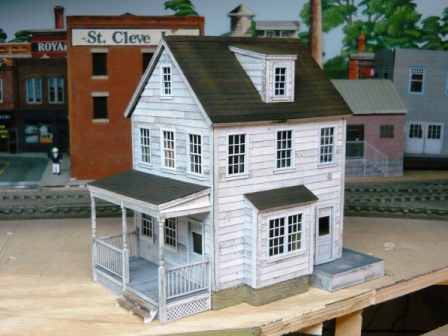The station buildings at Jabulani will be based on those at Hilton, to the northwest of Pietermaritzburg, in Natal, South Africa. Although Hilton is on a 3'6" "standard" or "Cape" gauge line, the design is typical of buildings used for 2' narrow gauge lines as well.
The fictional Jabulani station is set farther north, in the area near Melmoth and Babanango, Zululand, where no rail line was built, but this fiction allows me a little more creative leeway, and allow me to excuse any "mistakes".
Hilton's buildings are wood framed and covered completely in corrugated iron. In addition to the station building itself, there are a ladies' waiting room, toilets, lamp hut, and goods shed.
The materials for the station build are foam core board, watercolor paper, various widths of card stock, clear plastic sheet, drafting tape, and some styrene strips for the roof supports. The biggest challenges will be mixing paint in the right proportions to get the proper shades of colors faded in the South African sun, and deciding on the type of material to simulate the corrugated iron sheeting.
There are many materials on the market specifically made to simulate corrugated iron.
Campbell Scale Models (and other companies) produce scale corrugated aluminum sheets. Several other sources, such as
Brunel Models, make scale tools to produce your own corrugated sheets from aluminum foil. I have used both products to good effect for metal roofs that need to show the effects of age on individual sheets of corrugated iron.
However, for Jabulani station, I wanted the effect to be of a station building in relatively good repair, with minimal seems showing between the sheets of corrugated iron. Since the entire building was to be covered, I also wanted a material that was inexpensive and could take a bit more handling than thin aluminum. I finally settled on a sheet of ribbed scrapbooking paper from the local craft store, which appears to be closer to S scale, but comes in one-foot square sheets for about one dollar each. The only drawback is that it seems to only be available in a metallic aquamarine color, but a shot of grey primer took care of that.
The plan for the wall panels was laid out on 3/16 inch foam core board...
...and first the window and door openings were cut, and then the wall sections themselves.
I don't give much careful attention to getting walls square. I mainly just line them up with the grid on the cutting mat, and if they are a millimeter off, it all comes out well-enough at the end. My glue of choice for foam core board is Scotch brand Quick-Dry adhesive. It dries clear and forms a strong bond between different types of materials.
Once all the walls are together, I leave the thing alone to allow the glue to firm up overnight.
Next, the corrugated sheeting and paint......



.JPG)




.JPG)









+of+009.JPG)

